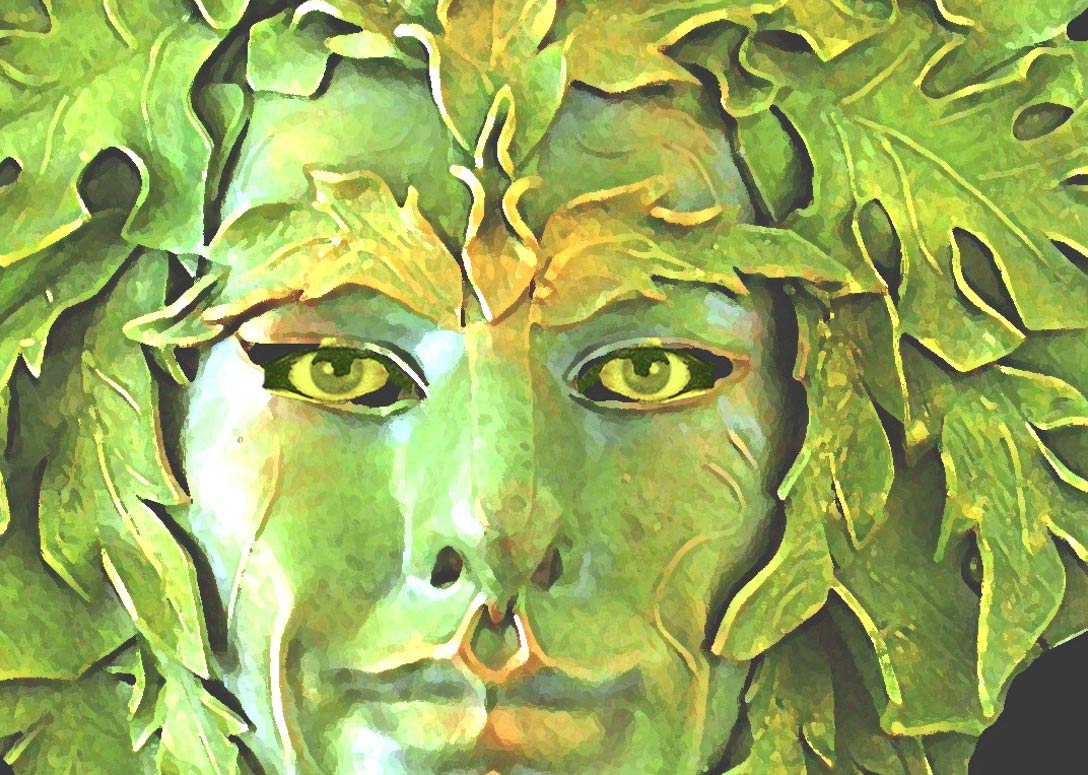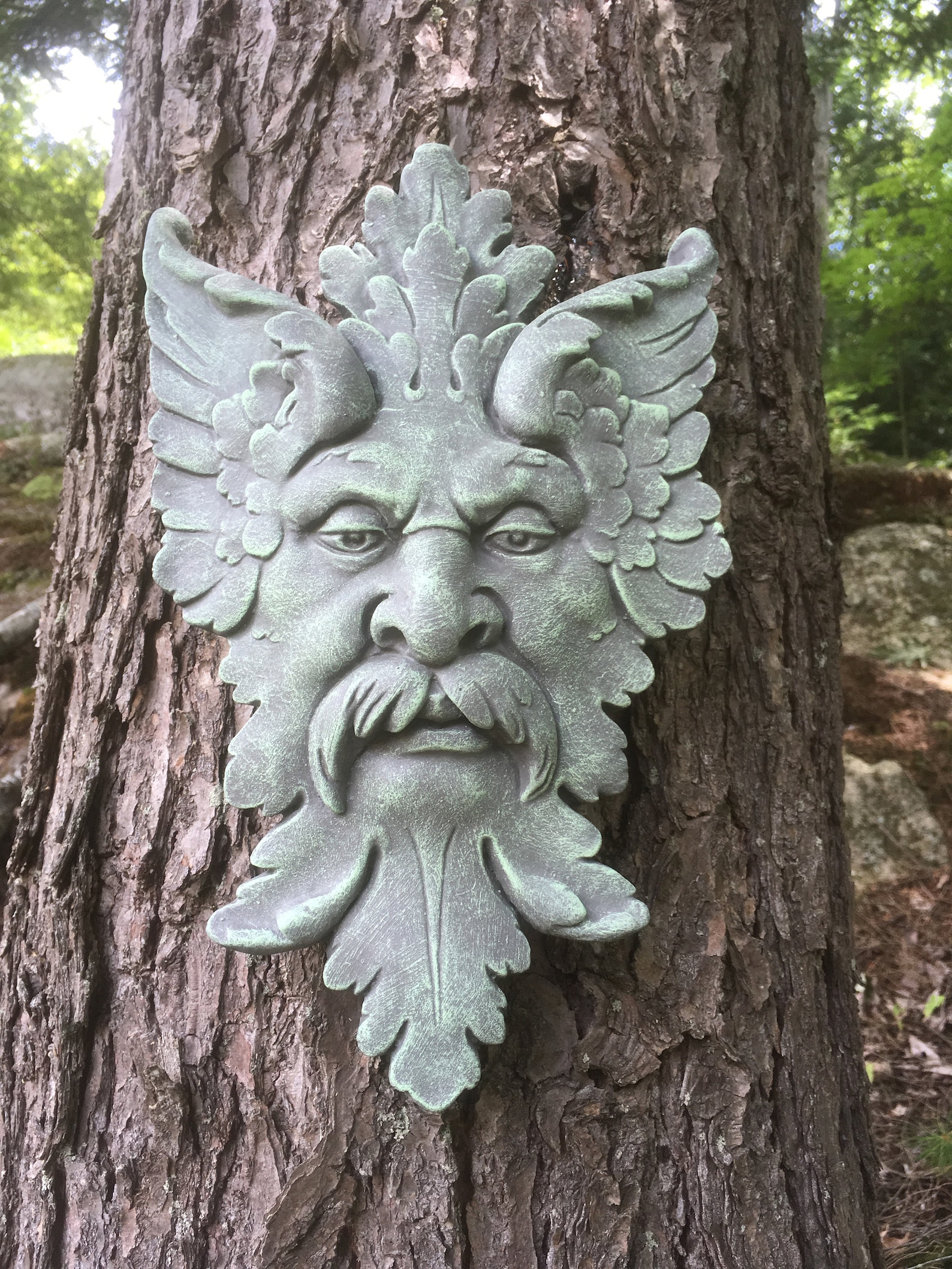The Green Man An Anchient Celtic Symbol Of Rebirth
Grouchy Green Man Garden Face, Whimsical Garden Stone Gift For The Gardener, Keep Out Stone Sculptrue Wall Plaque for Fence, Deck or Garage. (657) $72.00. FREE shipping. Green Man is a wall art sculpture for home or garden decor. A great Christmas or birthday gift for plant lovers and mythology buffs. (12) $43.40. $45.69 (5% off)

Wise green man wall plaque a smiley friendly face surrounded by leaves hand cast at our
Personal photo Ray Robinson, also known as "Charlie No-Face.". The legend of The Green Man states that he glows green as a result of being struck by lightning or being shocked in some kind of industrial accident. He also haunts South Park, the North Hills, or the country lanes around Washington, Pennsylvania. "The legend goes that he.

Pin by Lynda Jennings on Garden Decor Green man, Green man sculpture, Art
In this post about the Green Man, a figure from traditional folk culture, we look at connections between the Wild Man figure known as a Green Man in sixteenth-century England and the Foliate Head, a carved image of a face surrounded by or disgorging leaves. We demonstrate that this connection was made by artists in the Middle Ages and Renaissance before it was suggested by scholars.

Playlist Green Man 2018 Wales Arts Review
The Green Man, also known as a foliate head, is a motif in architecture and art, of a face made of, or completely surrounded by, foliage, which normally spreads out from the centre of the face. Apart from a purely decorative function, the Green Man is primarily interpreted as a symbol of rebirth, representing the cycle of new growth that occurs every spring.

Green Man Mask Etsy
The Green Man, also known as a foliate head, [1] is a motif in architecture and art, of a face made of, or completely surrounded by, foliage, which normally spreads out from the centre of the face. [2] Apart from a purely decorative function, the Green Man is primarily interpreted as a symbol of rebirth, representing the cycle of new growth.

Green Man Legend and Mythology Spirit of the Green Man
The Green Man is usually portrayed as a green face motif on sculptures, buildings, carvings, and, sometimes on paintings. The exact features of the face aren't set in stone - pardon the pun - and the Green Man doesn't seem to be a single person the way most gods are. However, the face is almost always bearded and covered with leaves.

Flickr Green man, Green man tattoo, Celtic tree tattoos
For the regular speed, narrated tutorial version of this video, follow this link: https://youtu.be/-biUFr9qIBo - Please rate the video, comment, share and su.

Unraveling the Nature and Identity of the Green Man Ancient Origins
Ceramic Green Man Face Tile, 1 pc, grass, forest guardian face tile for mosaics, arts and craft, celtic face tile, renaissance badge (502) $ 20.00. FREE shipping Add to Favorites Fabulous Green Man Ceramic Plaque (270) $ 35.00. FREE shipping Add to Favorites Leafman - Greenman - Nature man - Yard Art - Garden Decor - Green Leaf Face - Green.

Green Man Face. Wall Sculpture. Green man, Sculpture, Sculptures
The Green Man is mainly associated with the symbol of rebirth, representing the cycle of growth each spring. Some say he is the ancient guardian of the forest. Some speculate that the mythology of the Green Man developed independently in the traditions of separate ancient cultures and evolved into the wide variety of examples found throughout history..

Green Man Small Face Plaque Green man, Garden in the woods, Pagan gods
There's a theory that Green Man was once a central figure of May Day, in ancient Ireland called Beltane, a fire and fertility festival. While this theory is debated, we see a glimpse of the Green Man in figure Jack in the Green. Jack in the Green is a man clothed in foliage and paraded in a procession on May Day in modern times.

Greenman, by Walter Arnold who carved on the Washington National Cathedral Green man, Wood
This is our second post about the Green Man, a figure from traditional folk culture. It traces the meaning of the phrase "Green Man" from the 16th to the 20th centuries, providing a wealth of historical references to "green men," which were wild men covered in leaves, often armed with clubs. The post is richly illustrated with appearances of the Green Man in paintings, sculptures, engravings.

Green man, spirit of nature! RPF 2011 Green Man Sculpture, Sculpture Art, Ceramic Mask, Tree
The Mysterious Green Men in Medieval Churches. Medieval churches all over Europe are decorated with carved, leaf-covered faces called Green Men. But, after all these years, who they are and why they are there remains a mystery. If you enter one of those magnificent churches built during the Middle Ages and feel like you're being watched.

Green Man Garden Decor Hanging Face Concrete Garden Faces Etsy
The Green Man is almost frequently depicted as a man's face, usually ranging from middle aged to elderly, appearing out of the wild of forest trappings. His face is always encompassed by leaves, vines, and flowers, seeming to be literally born from the natural world. However, the slight variations on his images come from the exact way in which.

Green Man Face Concrete Garden Decor Cement Face Greenman Etsy Garden Shop, Garden Art, Garden
The Green Man, Charlie No-Face. Raymond Theodore Robinson (October 29, 1910 - June 11, 1985) was a disfigured American man whose years of nighttime walks made him into a figure of urban legend in western Pennsylvania. Robinson was so severely injured in a childhood electrical accident that he could not go out in public without fear of causing.

So Cool! Green man, Green man sculpture, Tree faces
A mask-like face engulfed in undergrowth, leaves sprouting eerily from his wretched mouth. Sometimes beautiful, often sinister, this mysterious figure - so common in medieval sculpture - is.

Green Man Face Wall Plaque Indoor Outdoor Garden Decor Etsy
The Green Man is typically portrayed as a human face surrounded by dense foliage. Such images appear as far back as the eleventh century, in church carvings. As Christianity spread, the Green Man went into hiding, with stonemasons leaving secret images of his face around cathedrals and churches.